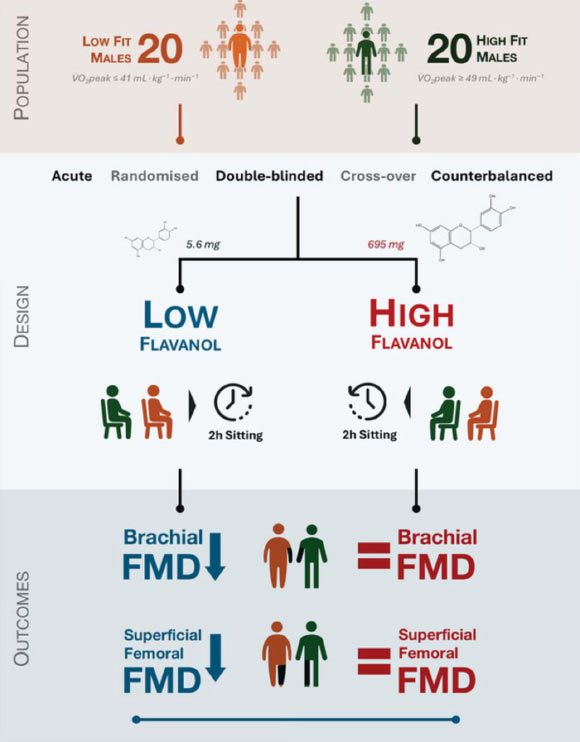Prolonged sitting temporarily impairs vascular function and blood pressure. Dietary strategies during sitting may ameliorate or aggravate the effects of sitting on vascular health. In a new study, dietary cocoa flavanols consumed just before 2 hours of uninterrupted sitting were effective at preventing sitting-induced reductions in vascular function in young healthy men. Flavanols were equally effective at preserving vascular function in individuals with high and low cardiorespiratory fitness during sitting. Individuals’ high cardiorespiratory fitness did not protect against declines in vascular function and blood pressure during sitting.

Consuming high-flavanol foods during sedentary periods may be used alone or in combination with other strategies (e.g. breaking up sitting) to reduce the impact of inactivity on the vascular system. Image credit: Daniele et al., doi: 10.1113/JP289038.
Sedentary behavior is extremely prevalent in modern societies.
Over the past two decades, it is estimated that the prevalence of sedentary behaviors — particularly sitting time — increased from 5.5 to 6.5 hours per day (equivalent to 18.2%) among young adults in the United States.
Sitting is a very common type of sedentary behavior that includes leisure activities such as watching TV and playing video games, as well as occupational sitting and commuting.
Previous studies have shown that a 1% reduction in vascular function, as measured by brachial flow-mediated dilatation (FMD), which measures the elasticity of the arteries, leads to a 13% increased risk of cardiovascular disease, such as heart disease, strokes, and heart attacks.
University of Birmingham researcher Catarina Rendeiro and her colleagues wanted to explore if there was a way that diet, particularly foods that are high in flavanols, could help protect against the risk to our vascular system associated with periods of uninterrupted sitting.
Flavanols are a type of polyphenol compound that occur naturally in some fruits, tea, and nuts, and cocoa beans.
They have been shown to have cardiovascular health benefits, such as protecting the vascular system during periods of mental stress.
“Whether we are sitting at desks, behind the wheel of a car, on a train, or on the sofa reading a book or watching TV, we all spend a lot of time seated,” Dr. Rendeiro said.
“Even though we are not moving our bodies, we are still putting them under stress.”
“Finding ways to mitigate the impact that sitting for uninterrupted periods has on our vascular system could help us cut the risk of developing cardiovascular diseases.”
The researchers tested whether consuming flavanols just before two hours of sitting could preserve blood vessel function in the arms and legs.
Forty young healthy men, 20 who had higher levels of fitness and 20 who had a lower level of fitness, consumed either a high-flavanol (695 mg of total flavanols per beverage) or low-flavanol cocoa drink (5.6 mg of total flavanols per beverage), before completing a two-hour sitting trial.
The study was not carried out with women, as changes in estrogen levels during the menstrual cycle are suspected to affect the impact of flavanols on vascular health during sitting. This should be the focus of another future trial.
The team took a range of vascular measures before and after sitting, including: (i) FMD in the superficial femoral artery and the brachial artery, (ii) arterial resting shear rate and blood flow, (iii) systolic and diastolic blood pressure, and (iv) leg muscle oxygenation.
Both the lower and higher fitness groups who had the low-flavanol cocoa before sitting, experienced FMD declines in the arteries in their arms and legs.
This suggests that higher levels of fitness do not provide protection from sitting.
It also significantly increased diastolic blood pressure, decreased shear rate and blood flow in both arteries, and resulted in declines in muscle oxygenation in both fitness groups.
However, the scientists found that those groups who consumed the high-flavanol cocoa drink, again in both fitness groups, did not experience FMD declines in either of the arteries in their arms or legs.
This is the first time flavanols have been shown to be effective at preventing sitting-induced vascular dysfunction, in young healthy men.
“Our experiment indicates that higher fitness levels do not prevent the temporary impairment of vascular function induced by sitting when only drinking low-flavanol cocoa,” said University of Birmingham’s Professor Sam Lucas.
“Importantly, after the high-flavanol drink, both fitter and less-fit participants kept their FMD the same as it was before sitting for two hours.”
The study is also the first to demonstrate that baseline levels of cardiorespiratory fitness do not alter the vascular effects of flavanol intake.
This means that individuals can benefit from flavanol intake regardless of their levels of physical fitness.
“It is actually quite easy to add high flavanol foods to your diet,” said University of Birmingham PhD student Alessio Daniele.
“There are cocoa products available in supermarkets and health stores which are processed through methods that preserve flavanol levels.”
“If cocoa isn’t your thing, fruits like apples, plums and berries, nuts, and black and green tea are all common kitchen staples and are readily available.”
“Our research shows that consuming high-flavanol foods and drinks during periods spent sitting down is a good way to reduce some of the impact of inactivity on the vascular system,” Dr. Rendeiro said.
“Given how common sedentary lifestyles have become and the increased risk this can have to vascular health, using flavanol-rich food and drink, especially in combination with breaking up periods of inactivity by going for a short walk or standing up, could be a good way to enhance long-term health, no matter the individual’s fitness level.”
The study was published in October 2025 in the Journal of Physiology.
_____
Alessio Daniele et al. Dietary flavanols preserve upper- and lower-limb endothelial function during sitting in high- and low-fit young healthy males. Journal of Physiology, published online October 29, 2025; doi: 10.1113/JP289038







